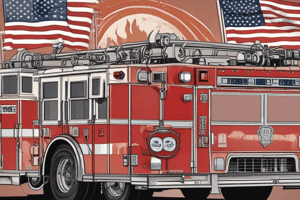Podcast
Questions and Answers
What are the Six Elements of Call for Fire?
What are the Six Elements of Call for Fire?
- Identification
- Warning Order
- Target Location
- All of the above (correct)
What is the first element of Call for Fire?
What is the first element of Call for Fire?
Identification
What does the Warning Order in Call for Fire indicate?
What does the Warning Order in Call for Fire indicate?
Type of mission
What are the three methods for target location?
What are the three methods for target location?
What is the Target Description acronym used in Call for Fire?
What is the Target Description acronym used in Call for Fire?
What does DAT stand for in Method of Engagement?
What does DAT stand for in Method of Engagement?
What is the Standard Method of Target Location?
What is the Standard Method of Target Location?
What is the Standard Trajectory for Artillery?
What is the Standard Trajectory for Artillery?
Which element of the Call for Fire specifies ammunition?
Which element of the Call for Fire specifies ammunition?
What is the purpose of direction in Call for Fire?
What is the purpose of direction in Call for Fire?
What are the five rules of direction in Call for Fire?
What are the five rules of direction in Call for Fire?
What does FDC need to know before a polar Call for Fire?
What does FDC need to know before a polar Call for Fire?
What increments do you send for direction?
What increments do you send for direction?
What is the minimum number of digits sent with a grid mission?
What is the minimum number of digits sent with a grid mission?
When do you announce direction when conducting an adjust fire, grid mission?
When do you announce direction when conducting an adjust fire, grid mission?
What are the four parts of the Message to Observer (MTO)?
What are the four parts of the Message to Observer (MTO)?
How is the term SHOT used in artillery communication?
How is the term SHOT used in artillery communication?
What does the term SPLASH indicate?
What does the term SPLASH indicate?
What does the term Rounds Complete signify?
What does the term Rounds Complete signify?
What is Spotting in artillery operations?
What is Spotting in artillery operations?
What is the Observer Target (OT) Factor used for?
What is the Observer Target (OT) Factor used for?
How do you determine the OT factor?
How do you determine the OT factor?
What is the formula to determine the deviation correction?
What is the formula to determine the deviation correction?
When should you not send a deviation correction?
When should you not send a deviation correction?
What is the standard trajectory for artillery?
What is the standard trajectory for artillery?
If the distance to your target is 3200 meters, what is your OT Factor?
If the distance to your target is 3200 meters, what is your OT Factor?
What is the minimal deviation correction you can send?
What is the minimal deviation correction you can send?
What is the book reference for Call for Fire?
What is the book reference for Call for Fire?
What will the first transmission consist of when you initiate a Call for Fire?
What will the first transmission consist of when you initiate a Call for Fire?
What increments do you send for distance when communicating?
What increments do you send for distance when communicating?
How do you calculate deviation corrections?
How do you calculate deviation corrections?
What is Danger Close for mortars and artillery?
What is Danger Close for mortars and artillery?
Flashcards are hidden until you start studying
Study Notes
Six Elements of Call for Fire
- Identification: Call sign of the observer and the unit being contacted.
- Warning Order: Specifies mission type; includes Adjust Fire, Fire for Effect, Immediate Supp/Smk, and Suppression.
- Target Location: Methods include Grid (MGRS), Polar (Direction & Distance), and Shift from a known point.
- Target Description: Includes Size/Element, Nomenclature/Nature, Activity, and Protection (acronym: SNAP).
- Method of Engagement: Specifies parameters such as Danger Close (600m), ammunition type (High Explosive, Point Detonation), and trajectory (Low/High Angle).
- Method of Fire and Control: Includes options like When Ready, At my Command, and Time on Target.
Target Location Methods
- Grid Method: Uses a minimum of 6 digits for MGRS; can send up to 10 digits, along with altitude.
- Polar Method: Involves specifying direction (nearest 10 mils), distance (nearest 100 meters), and elevation change (noted in increments).
Deviation Correction
- Calculated using OT Factor multiplied by spotting (OT x Spotting = Deviation Correction).
- The minimum deviation correction that can be sent is 30 meters.
Observer Target (OT) Factor
- Determined by dividing the distance from observer to target by 1000; express as a whole number or decimal depending on distance.
- Example: For a distance of 2700 meters, the OT Factor is 3.
Transmissions
- Message to Observer (MTO) includes: Call sign of unit(s), changes to Call for Fire, number of rounds per tube, and target number.
- Terms used: "SHOT" indicates each round fired during adjustment; "SPLASH" informs that a round is five seconds from detonation; "ROUND COMPLETE" signals the end of fire for effect phase.
Polar Missions
- Observer must send their location to the Fire Direction Control (FDC) before executing a Polar Call for Fire.
- Second transmission should include direction (nearest 10 mils) and distance (nearest 100 meters), alongside changes in elevation if necessary.
Successive Bracketing
- A technique used to establish a bracket where one round lands over and another short of the target, especially beneficial for inexperienced observers.
End of Mission
- Concludes the call for fire, including refining corrections, recording, and ensuring surveillance of the situation.
Danger Close
- For artillery and mortars, Danger Close is defined as 600 meters or less from friendly forces.
Standard Practices
- Standard trajectory for artillery is Low Angle.
- Standard method of target location in a CFF is Grid, when not specified otherwise.
- Always send direction in increments of 10 mils and distance in increments of 100 meters.
Additional Notes
- Ensure to correct deviations promptly. If correction is less than 30 meters, it does not require a correction.
- In case of polar calls, always specify elevation changes if they exceed 35 meters.
- Communication is critical; clarity in each transmission strengthens operational effectiveness.
Studying That Suits You
Use AI to generate personalized quizzes and flashcards to suit your learning preferences.



